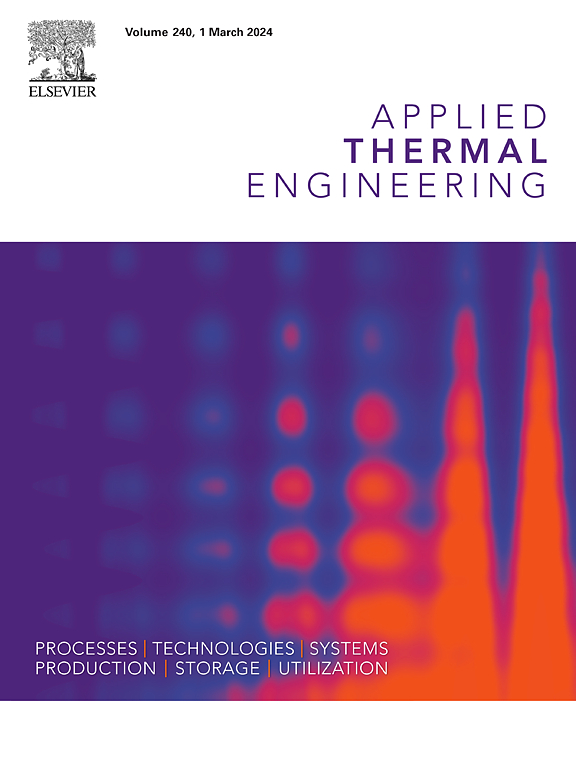无壳、无销、无垫片螺旋板式换热器的热、水力性能
IF 6.1
2区 工程技术
Q2 ENERGY & FUELS
引用次数: 0
摘要
热交换器是许多行业的基本部件,通过促进流体之间的热量传递,对效率和热性能做出了重大贡献。优化它们的效率和热性能仍然是一个关键目标。本研究介绍了一种螺旋板式换热器(SPHEs)的新设计,通过重大的结构修改解决了传统设计的局限性。针对特定的热交换任务,开发了一种新的SPHE设计,克服了传统配置的几个挑战。这个设计被转化为一个物理模型,并进行了广泛的评估。为了更深入地了解SPHE系统的热动力学,研究人员还开发了计算流体动力学(CFD)模型,并利用与新SPHE集成的专用试验台收集的实验数据对该模型进行了验证。通过实验研究来评估新型SPHE与传统设计相比的热性能和水力性能。测试的关键参数包括雷诺数(Re),范围从1000到2400,热液入口温度,范围从80°C到50°C。热性能指标显示,新的SPHE设计显着改善,热交换率平均提高28%,效率提高6.75%,传递单元数(NTU)提高17.3%,Biot数(Bi)提高35.3%。在水力方面,新设计表现出了卓越的性能,压降平均降低了32.1%,欧拉数和詹森数分别提高了32.1%和61%。这些结果突出了SPHE在热效率和水力效率方面的实质性进步,以及结构设计和制造工艺的改进。建议在未来的研究中对新设计进行具体应用评估,如区域供冷系统和能量转换和存储系统,以进一步验证其在实际运行条件下的优势。本文章由计算机程序翻译,如有差异,请以英文原文为准。
Thermal and hydraulic performance of caseless, pinless and gasket-free spiral plate heat exchanger
Heat exchangers are fundamental components across numerous industries, contributing significantly to efficiency and thermal performance by facilitating the transfer of heat between fluids. Optimizing their effectiveness and thermal performance remains a key objective. This study introduces a novel design for spiral plate heat exchangers (SPHEs), addressing limitations in conventional designs through significant structural modifications. A new SPHE design tailored for specific heat exchange duties was developed, overcoming several challenges of traditional configurations. This design was translated into a physical model and subjected to extensive evaluation. A computational fluid dynamics (CFD) model was also developed to provide deeper insights into the thermal dynamics of the SPHE system, with the model validated using experimental data collected from a purpose-built test rig integrated with the new SPHE. Experimental studies were conducted to evaluate the thermal and hydraulic performance of the new SPHE compared to conventional designs. Key parameters examined included the Reynolds number (Re), ranging from 1000 to 2400, and the hot liquid inlet temperature, varying from 80 °C to 50 °C. Thermal performance metrics showed notable improvements with the new SPHE design, achieving average increases of 28 % in heat exchange rate, 6.75 % in effectiveness, 17.3 % in the number of transfer units (NTU), and 35.3 % in the Biot number (Bi). Hydraulically, the new design demonstrated superior performance, with average reductions of 32.1 % in pressure drops and corresponding improvements of 32.1 % in the Euler number and 61 % in the Jensen number. These results highlight substantial advancements in the thermal and hydraulic efficiency of the proposed SPHE, coupled with improvements in structural design and manufacturing processes. Future research is recommended to evaluate the new design in specific applications, such as district cooling systems and energy conversion and storage systems, to further validate its advantages under practical operating conditions.
求助全文
通过发布文献求助,成功后即可免费获取论文全文。
去求助
来源期刊

Applied Thermal Engineering
工程技术-工程:机械
CiteScore
11.30
自引率
15.60%
发文量
1474
审稿时长
57 days
期刊介绍:
Applied Thermal Engineering disseminates novel research related to the design, development and demonstration of components, devices, equipment, technologies and systems involving thermal processes for the production, storage, utilization and conservation of energy, with a focus on engineering application.
The journal publishes high-quality and high-impact Original Research Articles, Review Articles, Short Communications and Letters to the Editor on cutting-edge innovations in research, and recent advances or issues of interest to the thermal engineering community.
 求助内容:
求助内容: 应助结果提醒方式:
应助结果提醒方式:


